Abstract
Forty homolog-scanning (double-reciprocal-crossover) mutant proteins of two Bacillus thuringiensis delta-endotoxin genes (cryIAa and cryIAc) were examined for potential structural alterations by a series of proteolytic assays. Three groups of mutants could be identified. Group 1, consisting of 13 mutants, showed no delta-endotoxin present during overexpression conditions in Escherichia coli (48 h at 37 degrees C, with a ptac promoter). These mutants produced full-sized delta-endotoxin detectable by polyacrylamide gel electrophoresis with Coomassie blue staining or Western immunoanalysis after 24 h of growth but not after 48 h, suggesting sensitivity to intracellular proteases. Group 2 consisted of 13 mutants that produced stable delta-endotoxins that were completely digested by 2% bovine trypsin. In contrast, native delta-endotoxin produces a 65,000-Da trypsin-resistant peptide, which is the active toxin. Group 3 mutants expressed delta-endotoxin and trypsin-stable toxins, similar to the wild type. In this study, 12 group 3 mutant toxins were compared with wild type toxins by thermolysin digestion at a range of temperatures. The two wild-type toxins exhibited significant differences in thermolysin digestion midpoints. Among the group 3 mutants, most possessed significantly different protein stabilities relative to their parental toxins. Two of the group 3 mutants were observed to have exchanged the thermolysin sensitivity properties of the parental toxins.
Full text
PDF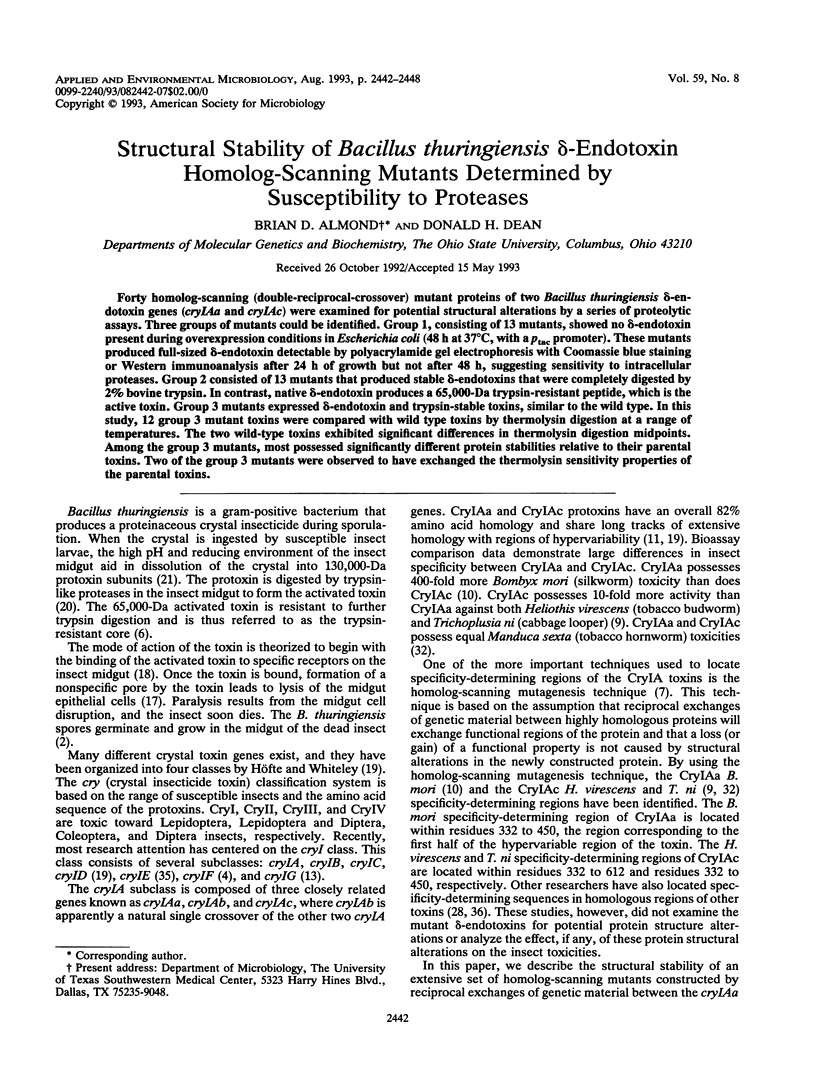
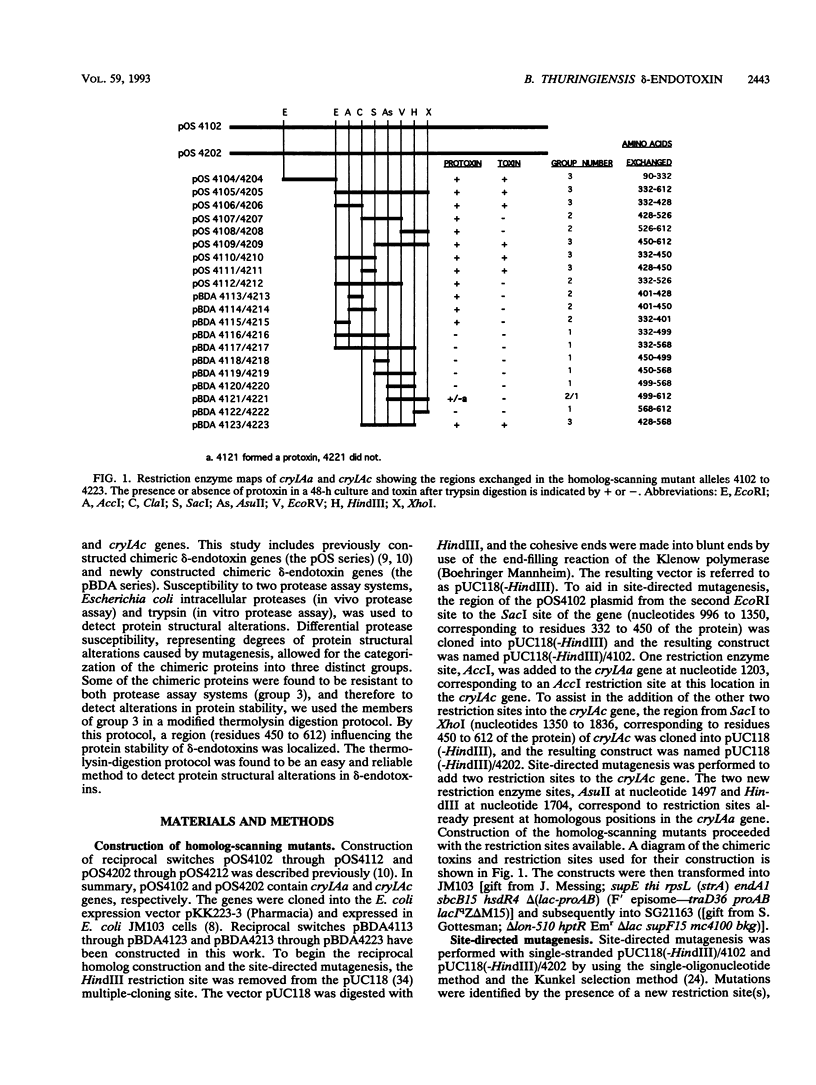
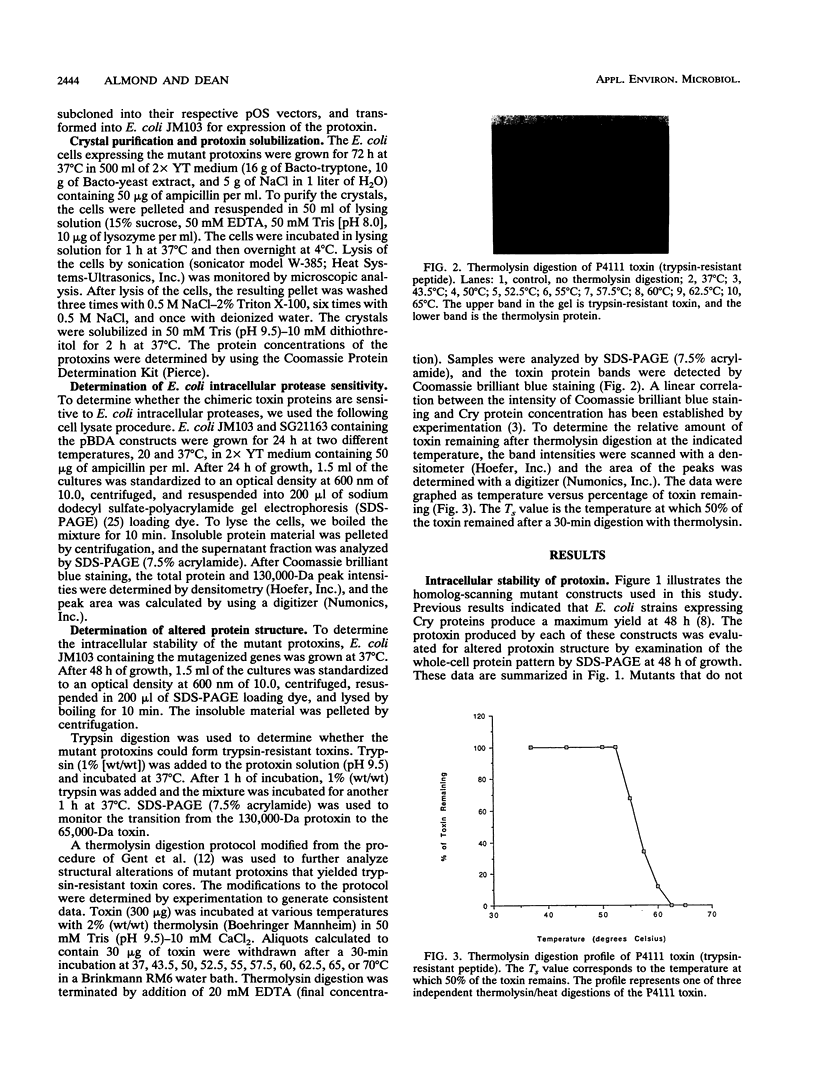
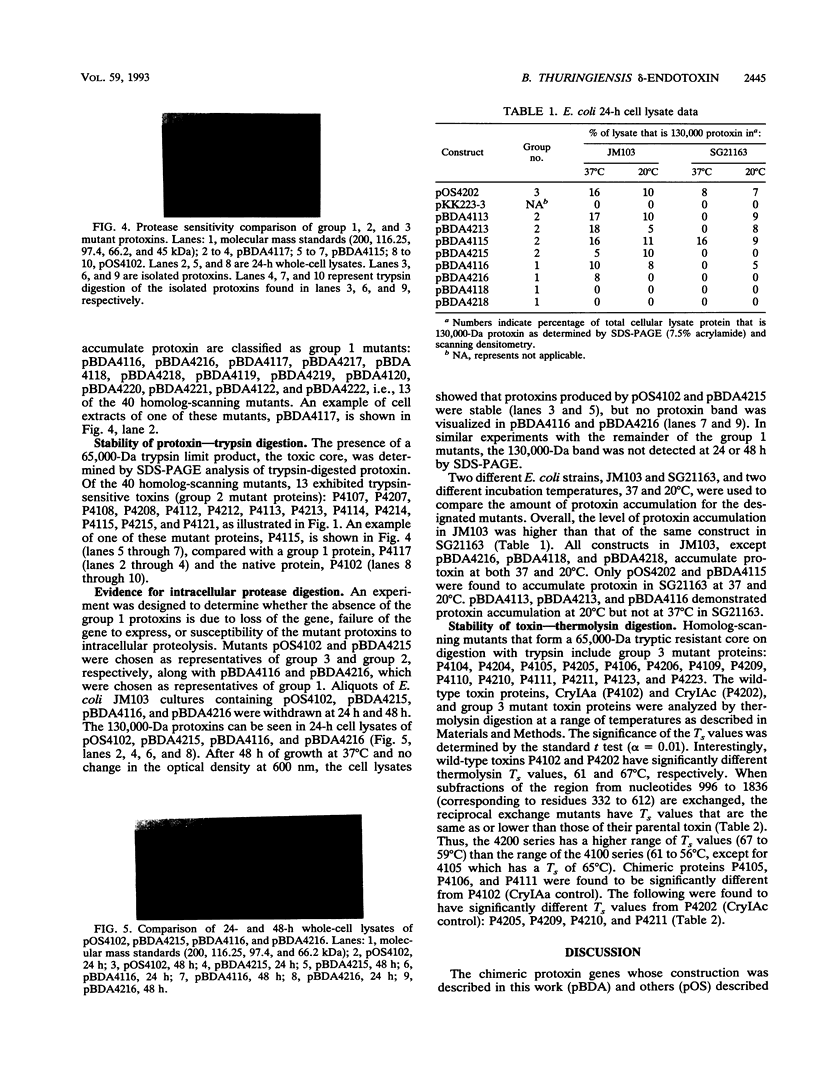
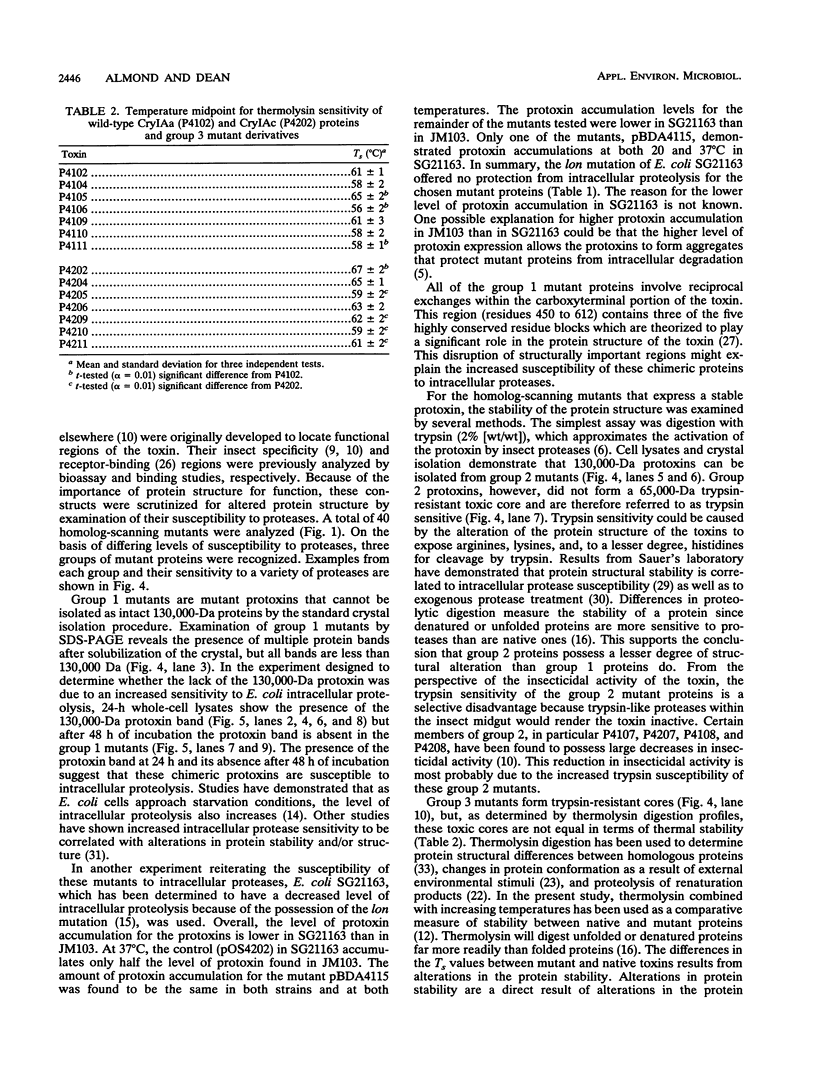
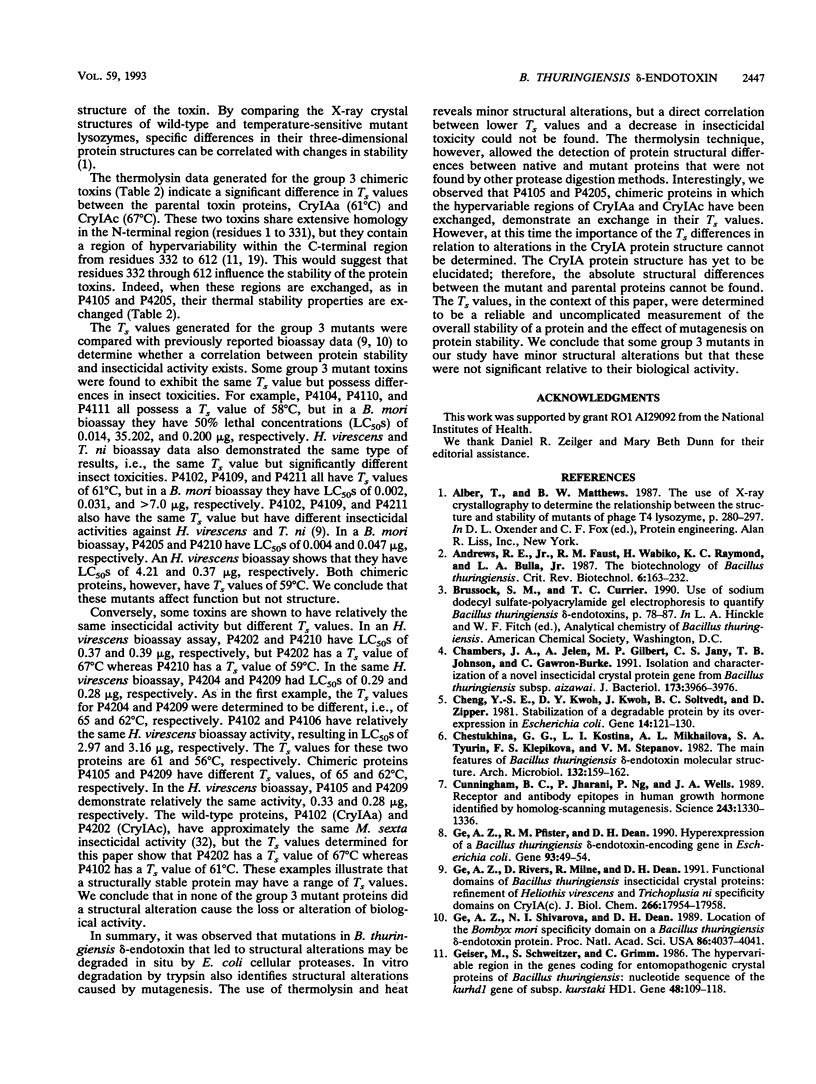
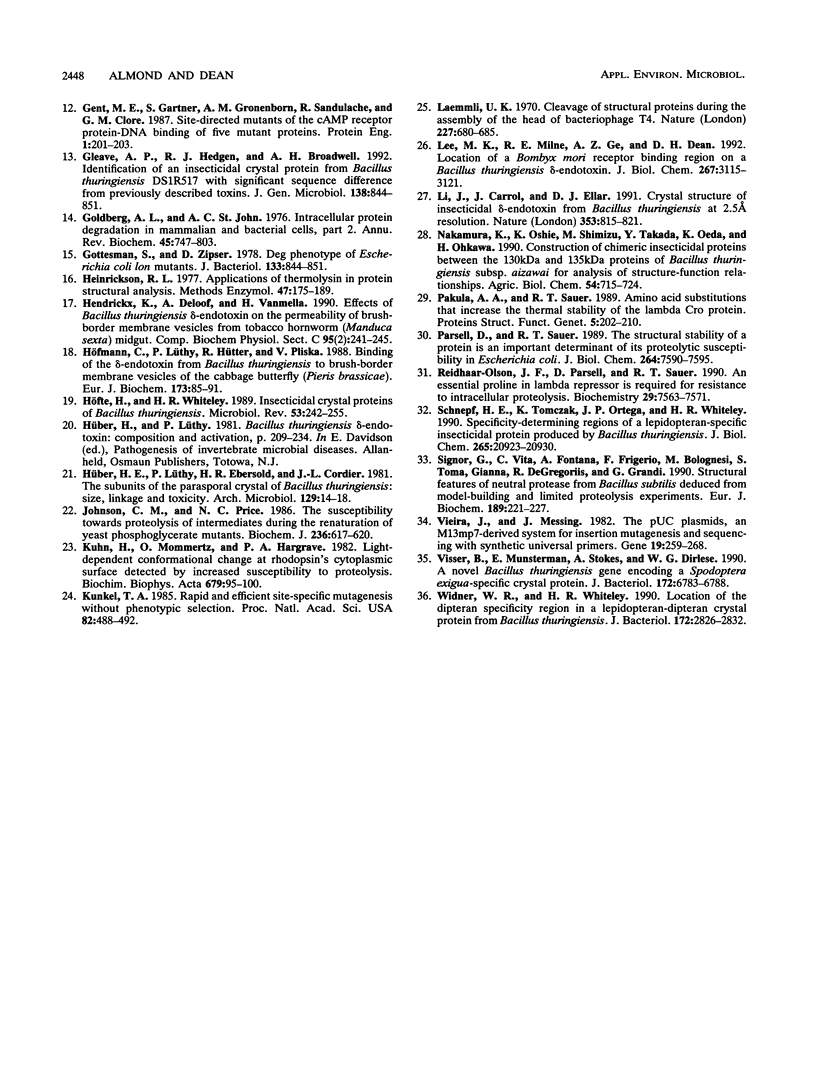
Images in this article
Selected References
These references are in PubMed. This may not be the complete list of references from this article.
- Andrews R. E., Jr, Faust R. M., Wabiko H., Raymond K. C., Bulla L. A., Jr The biotechnology of Bacillus thuringiensis. Crit Rev Biotechnol. 1987;6(2):163–232. doi: 10.3109/07388558709113596. [DOI] [PubMed] [Google Scholar]
- Chambers J. A., Jelen A., Gilbert M. P., Jany C. S., Johnson T. B., Gawron-Burke C. Isolation and characterization of a novel insecticidal crystal protein gene from Bacillus thuringiensis subsp. aizawai. J Bacteriol. 1991 Jul;173(13):3966–3976. doi: 10.1128/jb.173.13.3966-3976.1991. [DOI] [PMC free article] [PubMed] [Google Scholar]
- Cheng Y. S., Kwoh D. Y., Kwoh T. J., Soltvedt B. C., Zipser D. Stabilization of a degradable protein by its overexpression in Escherichia coli. Gene. 1981 Jun-Jul;14(1-2):121–130. doi: 10.1016/0378-1119(81)90154-2. [DOI] [PubMed] [Google Scholar]
- Cunningham B. C., Jhurani P., Ng P., Wells J. A. Receptor and antibody epitopes in human growth hormone identified by homolog-scanning mutagenesis. Science. 1989 Mar 10;243(4896):1330–1336. doi: 10.1126/science.2466339. [DOI] [PubMed] [Google Scholar]
- Ge A. Z., Pfister R. M., Dean D. H. Hyperexpression of a Bacillus thuringiensis delta-endotoxin-encoding gene in Escherichia coli: properties of the product. Gene. 1990 Sep 1;93(1):49–54. doi: 10.1016/0378-1119(90)90134-d. [DOI] [PubMed] [Google Scholar]
- Ge A. Z., Rivers D., Milne R., Dean D. H. Functional domains of Bacillus thuringiensis insecticidal crystal proteins. Refinement of Heliothis virescens and Trichoplusia ni specificity domains on CryIA(c). J Biol Chem. 1991 Sep 25;266(27):17954–17958. [PubMed] [Google Scholar]
- Ge A. Z., Shivarova N. I., Dean D. H. Location of the Bombyx mori specificity domain on a Bacillus thuringiensis delta-endotoxin protein. Proc Natl Acad Sci U S A. 1989 Jun;86(11):4037–4041. doi: 10.1073/pnas.86.11.4037. [DOI] [PMC free article] [PubMed] [Google Scholar]
- Geiser M., Schweitzer S., Grimm C. The hypervariable region in the genes coding for entomopathogenic crystal proteins of Bacillus thuringiensis: nucleotide sequence of the kurhd1 gene of subsp. kurstaki HD1. Gene. 1986;48(1):109–118. doi: 10.1016/0378-1119(86)90357-4. [DOI] [PubMed] [Google Scholar]
- Gent M. E., Gärtner S., Gronenborn A. M., Sandulache R., Clore G. M. Site-directed mutants of the cAMP receptor protein--DNA binding of five mutant proteins. Protein Eng. 1987 Jun;1(3):201–203. doi: 10.1093/protein/1.3.201. [DOI] [PubMed] [Google Scholar]
- Goldberg A. L., St John A. C. Intracellular protein degradation in mammalian and bacterial cells: Part 2. Annu Rev Biochem. 1976;45:747–803. doi: 10.1146/annurev.bi.45.070176.003531. [DOI] [PubMed] [Google Scholar]
- Gottesman S., Zipser D. Deg phenotype of Escherichia coli lon mutants. J Bacteriol. 1978 Feb;133(2):844–851. doi: 10.1128/jb.133.2.844-851.1978. [DOI] [PMC free article] [PubMed] [Google Scholar]
- Heinrikson R. L. Applications of thermolysin in protein structural analysis. Methods Enzymol. 1977;47:175–189. doi: 10.1016/0076-6879(77)47022-8. [DOI] [PubMed] [Google Scholar]
- Hendrickx K., De Loof A., Van Mellaert H. Effects of Bacillus thuringiensis delta-endotoxin on the permeability of brush border membrane vesicles from tobacco hornworm (Manduca sexta) midgut. Comp Biochem Physiol C. 1990;95(2):241–245. doi: 10.1016/0742-8413(90)90112-m. [DOI] [PubMed] [Google Scholar]
- Hofmann C., Lüthy P., Hütter R., Pliska V. Binding of the delta endotoxin from Bacillus thuringiensis to brush-border membrane vesicles of the cabbage butterfly (Pieris brassicae). Eur J Biochem. 1988 Apr 5;173(1):85–91. doi: 10.1111/j.1432-1033.1988.tb13970.x. [DOI] [PubMed] [Google Scholar]
- Höfte H., Whiteley H. R. Insecticidal crystal proteins of Bacillus thuringiensis. Microbiol Rev. 1989 Jun;53(2):242–255. doi: 10.1128/mr.53.2.242-255.1989. [DOI] [PMC free article] [PubMed] [Google Scholar]
- Johnson C. M., Price N. C. The susceptibility towards proteolysis of intermediates during the renaturation of yeast phosphoglycerate mutase. Biochem J. 1986 Jun 1;236(2):617–620. doi: 10.1042/bj2360617. [DOI] [PMC free article] [PubMed] [Google Scholar]
- Kunkel T. A. Rapid and efficient site-specific mutagenesis without phenotypic selection. Proc Natl Acad Sci U S A. 1985 Jan;82(2):488–492. doi: 10.1073/pnas.82.2.488. [DOI] [PMC free article] [PubMed] [Google Scholar]
- Laemmli U. K. Cleavage of structural proteins during the assembly of the head of bacteriophage T4. Nature. 1970 Aug 15;227(5259):680–685. doi: 10.1038/227680a0. [DOI] [PubMed] [Google Scholar]
- Lee M. K., Milne R. E., Ge A. Z., Dean D. H. Location of a Bombyx mori receptor binding region on a Bacillus thuringiensis delta-endotoxin. J Biol Chem. 1992 Feb 15;267(5):3115–3121. [PubMed] [Google Scholar]
- Li J. D., Carroll J., Ellar D. J. Crystal structure of insecticidal delta-endotoxin from Bacillus thuringiensis at 2.5 A resolution. Nature. 1991 Oct 31;353(6347):815–821. doi: 10.1038/353815a0. [DOI] [PubMed] [Google Scholar]
- Nakamura K., Oshie K., Shimizu M., Takada Y., Oeda K., Ohkawa H. Construction of chimeric insecticidal proteins between the 130-kDa and 135-kDa proteins of Bacillus thuringiensis subsp. aizawai for analysis of structure-function relationship. Agric Biol Chem. 1990 Mar;54(3):715–724. [PubMed] [Google Scholar]
- Pakula A. A., Sauer R. T. Amino acid substitutions that increase the thermal stability of the lambda Cro protein. Proteins. 1989;5(3):202–210. doi: 10.1002/prot.340050303. [DOI] [PubMed] [Google Scholar]
- Parsell D. A., Sauer R. T. The structural stability of a protein is an important determinant of its proteolytic susceptibility in Escherichia coli. J Biol Chem. 1989 May 5;264(13):7590–7595. [PubMed] [Google Scholar]
- Reidhaar-Olson J. F., Parsell D. A., Sauer R. T. An essential proline in lambda repressor is required for resistance to intracellular proteolysis. Biochemistry. 1990 Aug 21;29(33):7563–7571. doi: 10.1021/bi00485a004. [DOI] [PubMed] [Google Scholar]
- Schnepf H. E., Tomczak K., Ortega J. P., Whiteley H. R. Specificity-determining regions of a lepidopteran-specific insecticidal protein produced by Bacillus thuringiensis. J Biol Chem. 1990 Dec 5;265(34):20923–20930. [PubMed] [Google Scholar]
- Signor G., Vita C., Fontana A., Frigerio F., Bolognesi M., Toma S., Gianna R., De Gregoriis E., Grandi G. Structural features of neutral protease from Bacillus subtilis deduced from model-building and limited proteolysis experiments. Eur J Biochem. 1990 Apr 30;189(2):221–227. doi: 10.1111/j.1432-1033.1990.tb15480.x. [DOI] [PubMed] [Google Scholar]
- Vieira J., Messing J. The pUC plasmids, an M13mp7-derived system for insertion mutagenesis and sequencing with synthetic universal primers. Gene. 1982 Oct;19(3):259–268. doi: 10.1016/0378-1119(82)90015-4. [DOI] [PubMed] [Google Scholar]
- Visser B., Munsterman E., Stoker A., Dirkse W. G. A novel Bacillus thuringiensis gene encoding a Spodoptera exigua-specific crystal protein. J Bacteriol. 1990 Dec;172(12):6783–6788. doi: 10.1128/jb.172.12.6783-6788.1990. [DOI] [PMC free article] [PubMed] [Google Scholar]
- Widner W. R., Whiteley H. R. Location of the dipteran specificity region in a lepidopteran-dipteran crystal protein from Bacillus thuringiensis. J Bacteriol. 1990 Jun;172(6):2826–2832. doi: 10.1128/jb.172.6.2826-2832.1990. [DOI] [PMC free article] [PubMed] [Google Scholar]





